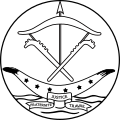| Coat of arms of Benin |
|---|
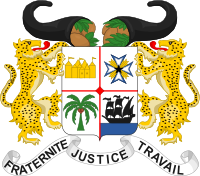 |
|
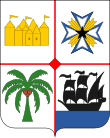 Lesser version |
|
|---|
| Armiger | Republic of Benin |
|---|
| Adopted | 1990 (1964) |
|---|
| Crest | Two cornucopias sable, ears of corn coming therefrom; |
|---|
| Shield | Quarterly,1, Argent, a Somba Castle Or, 2, Argent, a Star of Benin proper, 3, Argent, a Palm Tree vert charged with fruit gules, 4, Argent, a ship sable sailing on a sea azure with a sewn upon the line of quartering a lozenge gules |
|---|
| Supporters | Two panthers or spotted |
|---|
| Motto | Fraternité, Justice, Travail
"Fraternity, Justice, Labour" |
|---|
The coat of arms or national seal of Benin , originally introduced in 1964, [1] was readopted in 1990 after being replaced in 1975.
At the top of the emblem is the national crest that consists of two horns with corn in the ear and filled with sand. These are reputed to stand for prosperity. Below the crest is a shield that contains the actual coat of arms of Benin.
The shield is broken into four quadrants. The top left quadrant contains a castle in the style of the Somba, representative of the history of Benin. In the top right quadrant, is the Star of Benin, the highest award of the nation. Below this is a ship, that stands for the arrival of Europeans in Benin. In the lower left quadrant is a palm tree.
The shield is supported by a pair of leopards, the national animal of Benin. Below the shield is the motto of Benin (Fraternity, Justice, Labour) in French.

The coat of arms of the state of New York was formally adopted in 1778, and appears as a component of the state's flag and seal.

The coat of arms of Nunavut was granted by a warrant of Roméo LeBlanc, Governor General of Canada, dated 31 March 1999, one day before the territory of Nunavut, Canada, was created. The same document specified the flag of Nunavut.
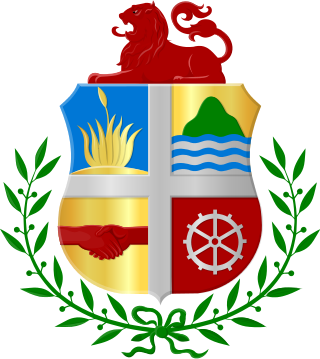
The Coat of arms of Aruba has been officially in use since November 15, 1955, as the recognized national symbol of Aruba.

The coat of arms of Toronto is a heraldic symbol used to represent the city Toronto. Designed by Robert Watt, the Chief Herald of Canada at the time, for the City of Toronto after its amalgamation in 1998. The arms were granted by the Canadian Heraldic Authority on 11 January 1999.

The coat of arms of the Kingdom of the Netherlands was originally adopted in 1815 and later modified in 1907. The arms are a composite of the arms of the former Dutch Republic and the arms of the House of Nassau, it features a checkered shield with a lion grasping a sword in one hand and a bundle of arrows in the other and is the heraldic symbol of the monarch and the country. The monarch uses a version of the arms with a mantle while the government of the Netherlands uses a smaller version without the mantle (cloak) or the pavilion, sometimes only the shield and crown are used. The components of the coats of arms were regulated by Queen Wilhelmina in a royal decree of 10 July 1907, affirmed by Queen Juliana in a royal decree of 23 April 1980.

The coat of arms of Sunderland is the official heraldic arms of the City of Sunderland in England.

The great seal of the state of Delaware was first adopted on January 17, 1777, with the current version being adopted April 29, 2004. It contains the state coat of arms surrounded by an inscription.

The coat of arms of Sierra Leone, were developed by the College of Arms and granted in 1960.

The coat of arms of Namibia is the official heraldic symbol of Namibia. Introduced at the time of independence in 1990, it superseded the earlier coat of arms used by the South African administration of the territory.

The coat of arms of Togo was adopted on 14 March 1962. Since this Togolese national symbol does not follows the rules of heraldry for a traditional coat of arms, then it could be considered a national emblem instead.

The coat of arms of Cape Town is the traditional symbol of the municipality of Cape Town. The original arms from the 20th century are no longer in official use, though no new arms have yet been adopted.
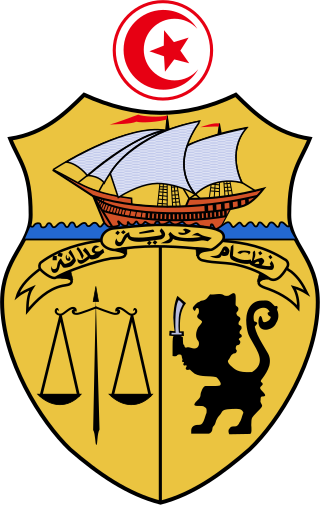
The coat of arms of Tunisia is divided into three parts. The upper part features a Carthaginian galley sailing on the sea. The lower part is itself divided vertically: on the left there is a black scale and on the right a black lion grasping a silver scimitar. Between the two parts is a banner bearing the national motto: “Freedom, Order, Justice”. Finally, at the top of the coat of arms is a circle with a red border into which is inserted the red crescent and star appearing on the flag of Tunisia.

In heraldry and heraldic vexillology, a blazon is a formal description of a coat of arms, flag or similar emblem, from which the reader can reconstruct the appropriate image. The verb to blazon means to create such a description. The visual depiction of a coat of arms or flag has traditionally had considerable latitude in design, but a verbal blazon specifies the essentially distinctive elements. A coat of arms or flag is therefore primarily defined not by a picture but rather by the wording of its blazon. Blazon is also the specialized language in which a blazon is written, and, as a verb, the act of writing such a description. Blazonry is the art, craft or practice of creating a blazon. The language employed in blazonry has its own vocabulary, grammar and syntax, which becomes essential for comprehension when blazoning a complex coat of arms.

The coat of arms of Dominica was adopted on July 21, 1961. It consists of a shield with two guardian sisserou parrots bracing the shield atop of which is a lion passant. The quarters of the shield depict a canoe, a banana tree, a palm and a frog of the native species known as the mountain chicken. Below the shield is the national motto: Apres Bondie C'est La Ter.

The coat of arms of the Department of Bolívar is the official coat of arms of the Department of Bolívar. The coat of arms had been in used before 1856, but in that year the Sovereign State of Bolívar was created, and its symbols changed; the new coat of arms, would be the same as the coat of arms of Colombia but with a red oval around it, that read “ESTADO SOBERANO DE BOLIVAR”. In 1886 the states were suppressed and departments created instead, the symbols were used once again but the originals were corrupted and so there are some variations on the current coat of arms, and that which was specified on the blazon.

The coat of arms of Kropyvnytskyi is one of the city's symbols reflecting its past and the controversies of its history.

The coat of arms of Malawi is based on the earlier heraldic arms of Nyasaland. It is supported by a lion and a leopard, above a scroll reading "Unity and Freedom". A rising sun in a black field, like in the lower field in the shield, is also present in the flag of Malawi.

The coat of arms of the Extremadura is described in the Title I of the Spanish Law 4 of June 3, 1985, the Law of the coat of arms, flag and regional day of Extremadura.
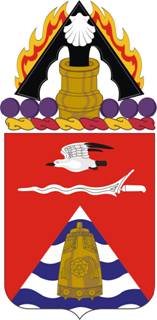
The 31st Field Artillery Regiment is a field artillery regiment of the United States Army, first Constituted in 1918 in the National Army (USA). The 1st Battalion, 31st Field Artillery, was constituted 5 July 1918 in the National Army as the 31st Field Artillery and assigned to the 11th Division. The "Proud American" Battalion was organized at Camp George G. Meade, Maryland 6 August 1918 but relieved thereafter from its assignment to the 11th Division on 30 September 1918. The unit demobilized 9 December 1918 at Camp George G. Meade, Maryland. On 22 July 1929, 31st FA was reconstituted in the Regular Army and assigned to the 2nd Division but was, once again, later relieved on 1 January 1930 from its assignment to the 2nd Division. The "Proud American" Battalion was subsequently assigned to the 7th Division on 1 July 1940 and activated at Camp Ord, California where it was reorganized and re-designated as the 31st Field Artillery Battalion on 1 October 1940. It underwent another reorganization and re-designation on 1 July 1957 as the 31st Field Artillery, "Always First," which was a parent regiment under the Combat Arms Regimental System. 31st FA was then withdrawn from the Combat Arms Regimental System 16 March 1989, reorganized under the United States Army Regimental System, and transferred to the United States Army Training and Doctrine Command (TRADOC). The unit was re-designated as the 31st Field Artillery Regiment on 1 October 2005 and began the reactivation process on 1 October 2010, attaining operational capacity under the 434th Field Artillery Brigade and activated on 11 January 2011. The "Proud American" Battalion is credited with participating in multiple campaigns in World War II and the Korean War. It has been distinguished with several decorations, to include the Philippine Presidential Unit Citation and the Republic of Korea Presidential Unit Citation that was awarded on three separate occasions.
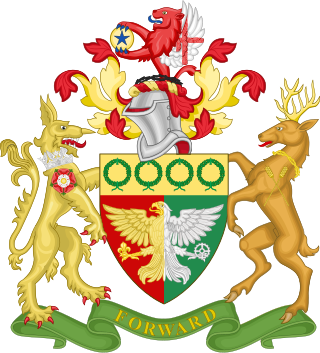
The coat of arms of the London Borough of Hillingdon is the official symbol of the London Borough of Hillingdon. They use elements from the coats of arms of the four previous districts. It is described as:
Arms: Per pale Gules and Vert an Eagle displayed per pale Or and Argent in the dexter claw a Fleur-de-lis Or and in the sinister claw a Cog-Wheel Argent on a Chief Or four Civic Crowns Vert.
Crest: On a Wreath of the Colours issuant from a Circlet of Brushwood Sable a demi-Lion Gules with wings Argent the underside of each wing charged with a Cross Gules and holding between the paws a Bezant thereon a Mullet Azure.
Supporters: On the dexter side an Heraldic Tiger Or gorged with an Astral Crown Azure and charged on the shoulder with a Rose Gules charged with another Argent barbed and seeded proper and on the sinister side a Stag proper attired and gorged with a Circlet of Brushwood and charged on the shoulder with two Ears of Rye slipped in saltire Or.
Motto: Forward.





